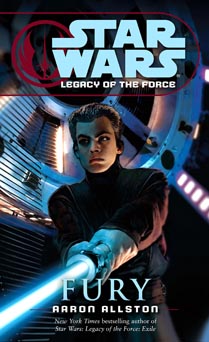“Fury” (2007), the seventh entry in the nine-book “Legacy of the Force” saga, is an example of a great book within a wider storyline that’s not so great. By this point, it’s clear that the Jacen Solo/Darth Caedus arc doesn’t ring true: He behaves like the Emperor, yet he doesn’t have a sociopathic background; he was quite the opposite as a kid. The idea that Jacen’s teachings from Vergere or his missing five years of secret Force studies (between “The New Jedi Order” and the “Dark Nest” trilogy) caused him to go dark is more of a placeholder for an explanation than an actual explanation.
Early on in his power play, Jacen decided that he needed to behave like the Emperor for logical reasons: Eventually, it would lead to peace and order, he thought. But in Aaron Allston’s “Fury,” he’s Force-choking innocent officers to death as an outlet for his rage over having his daughter, Allana, taken from him. Even Vader mostly killed people who were logical targets for his rage. As Caedus loses control of himself, a reader gets the feeling that the “LOTF” series is likewise losing control of his characterization.
However, “Fury” does cap the arc of a compelling villain – and one whose path makes more sense: Alema Rar. Although she was created by Troy Denning, Allston gets the honor of sending Alema out in tragic fashion. With her dying thought, she asks Jag to remember her from the days when she was “young, beautiful, strong, brave, loved, loving.” Alema lost her sister, Numa, in the Yuuzhan Vong war, and thus began her gradual unhinging from sanity. Unlike Jacen’s, Alema’s fall makes sense.
Oddly, our heroes note that Jacen will be much tougher to take out than Alema, but Alema shows dark-side abilities that top anything we’ve seen before. She can project herself to literally participate in a fight in another location – in fact, two different locations simultaneously – and she can transfer other people’s essences elsewhere. For example, she can move Jag’s life force into a mynock, and then by killing that mynock, she would kill Jag. The Korriban Sith enclave chooses not to team up with Alema, seeing her as too unstable, but they might’ve missed out on a powerful ally.
Allston’s biggest strength in “LOTF” is keeping a team of the old heroes together rather than showing friends fighting friends. Tycho and Syal join with the Jedi-led force in “Fury,” technically having been forced to do so; in a classic bit of Allston’s wry wartime humor, Wedge forms his fingers into a gun and “threatens” his best friend. Allston shows that military people can do the right thing rather than “just following orders,” although one could argue that Wedge’s and Tycho’s lack of fear of reprisals from their higher-ups is an uncommon trait.
I also like that the Jedi and Tenel Ka decide they won’t actively serve the Alliance again until Jacen (who, by the way, is still known as Darth Caedus only to himself at this point) is removed from power. Although Luke does not openly say he’s learning from the old Order’s mistakes, his approach makes for an interesting contrast with the Jedi who served the Republic in the Clone Wars without looking too closely at the specifics of the civil war. The main difference seems to be that Palpatine was better than Jacen at keeping his evilness under wraps.

“Fury” features a fun “I am your father” parallel when Jacen tells Allana “I’m your daddy.” Even though it makes Allana happy, it’s more chilling to a reader than the “Empire Strikes Back” scene.
As he ramps up to a conclusion similar to “A New Hope” and “Return of the Jedi,” with Centerpoint Station standing in for the Death Stars, Allston gives “Fury” even more deliciously “Star Wars-ian” trappings. Our heroes have rendezvous points at Maitell Base on Kashyyyk (Wookieepedia tells me this isn’t the site of the “Revenge of the Sith” battle, although that’s what I was picturing) and the old Imperial landing pad on Endor, plus a spot in the forest where a piece of the Death Star crashed. Luke holds a meeting in the cool shadow of the piece of wreckage, and snooping Ewoks add to the ambiance. (And in a nice inside joke, Allana seems to be watching the in-universe equivalent of “Ewoks: The Battle for Endor” at one point.)
For gamers, “Fury” offers the best book portrayal so far of Kyle Katarn — yes, that includes the “Dark Forces” illustrated books, where he was forgettable despite being the main character. He’s known in some circles as the Chuck Norris of “Star Wars,” although in the novels he had mostly just been a face in the crowd at Jedi meetings prior to this.
Allston’s character writing in “Fury” reaches a high point not seen since his “X-Wing” days, particularly in a standout sequence where teenage Ben scolds his father for wanting to join Mara in death. Ben has been a schizophrenic character in this series (remember when he tried to arrest Han and Leia?), but he’s turning a corner and becoming a hero worth rooting for.
The author also gradually builds up the mostly-ignored-to-this-point Jaina, dropping crumbs of hope for an eventually reunion with Jag and hinting that her distant moodiness comes from trying to be dark enough to kill Jacen. As is the case with this whole series, the hook of the last two books will be not be Jacen himself but rather how his former loved ones deal with him.

